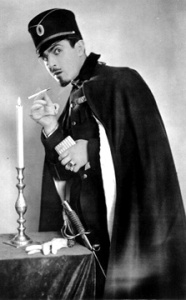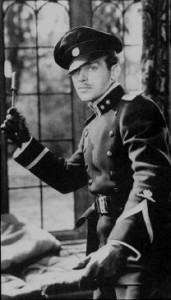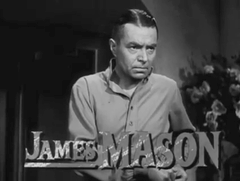Tags
Anthony Hope, Douglas Fairbanks Jr., James Mason, Ramon Novarro, Rupert of Hentzau, Swashaton, The Prisoner of Zenda
 This post is part of the Swashathon!, “a wild and adventurous event featuring the finest swashbucklers in the history of cinema”, hosted by Fritzi Kramer’s wonderful Movies Silently to celebrate the movie début of Douglas Fairbanks – right 100 years ago.
This post is part of the Swashathon!, “a wild and adventurous event featuring the finest swashbucklers in the history of cinema”, hosted by Fritzi Kramer’s wonderful Movies Silently to celebrate the movie début of Douglas Fairbanks – right 100 years ago.
Shall we begin?
Young Rupert, who looked a dare-devil, and could not have been more than twenty-two or twenty-three, took the lead, and made us the neatest speech, wherein my devoted subject and loving brother Michael of Strelsau, prayed me to pardon him for not paying his addresses in person, and, further, for not putting his Castle at my disposal; the reason for both of these apparent derelictions being that he and several of his servants lay sick of scarlet fever, and were in a very sad, and also a very infectious state. So declared young Rupert with an insolent smile on his curling upper lip and a toss of his thick hair—he was a handsome villain, and the gossip ran that many a lady had troubled her heart for him already.
Thus enter stage Rupert of Hentzau, in Chapter Twelve of Anthony Hope’s The Prisoner Of Zenda – after which he walks away with the book and never returns it. Why, the sequel is even called “Rupert of Hentzau”…
 It is a pet theory of mine that Hope’s intentions for Rupert may have gone a bit overboard. Unlike the hero Rudolf Rassendyll and his Ruritanian friends, the boy does not behave as a gentleman should – but, unlike them, he is certainly never boring. Charming, reckless, and with the moral compass of a coat-hanger, Rupert is easily the best character in the book- and in the sequel as well. While both narrators (Rassendlyll himself and his friend Fritz) take pains to inform us that he is a cheat, a liar, a womanizer and a murderer, that his wicked ways have broken his poor mother’s heart, and that he is evil in every possible way, they also spend a lot of words rhapsodising over young Rupert’s cleverness, charm, reckless bravery, beauty, superior horsemanship & swordmanship… Why, even his enemies can’t help liking the young rogue.
It is a pet theory of mine that Hope’s intentions for Rupert may have gone a bit overboard. Unlike the hero Rudolf Rassendyll and his Ruritanian friends, the boy does not behave as a gentleman should – but, unlike them, he is certainly never boring. Charming, reckless, and with the moral compass of a coat-hanger, Rupert is easily the best character in the book- and in the sequel as well. While both narrators (Rassendlyll himself and his friend Fritz) take pains to inform us that he is a cheat, a liar, a womanizer and a murderer, that his wicked ways have broken his poor mother’s heart, and that he is evil in every possible way, they also spend a lot of words rhapsodising over young Rupert’s cleverness, charm, reckless bravery, beauty, superior horsemanship & swordmanship… Why, even his enemies can’t help liking the young rogue.
It follows that, when bringing this story and its sequel to the screen, the casting of Rupert is a rather crucial choice. Between 1913 and 1964 he was played by Walter Hale, Gerald Ames, Ramon Novarro, Douglas Fairbanks, Jr. and James Mason, Farley Granger and Peter Wyngarde – but since all the silent versions before 1922 are either lost or buried in the Library of Congress, and old TV series are not terribly easy to come by, I’ll have to confine myself to only three Ruperts.
Let’s begin with Ramon Novarro in the 1922 Ingram version. Novarro is 23 – just the right age – and one gets the sense that his Rupert, with his monocle, goatee, walking stick, cigarettes, and dandyish ways, is trying to appear older. He manages to look older and more sophisticated than Fritz von Tarlenheim – but often young Hentzau comes across as a mischievous boy masquerading to fit in a world of older men. Then again, the masquerade is far from innocent, and Novarro’s Rupert likes his mischief to be of the lethal variety. He smirks, he blows clouds of smoke, he quizzes duller people (that is, everyone else) through his monocle, he cocks an eyebrow to the camera, he delivers drugged wine, he knifes obnoxious princes in the ribs – all with a nice air of urbane and amused arrogance. This Rupert clearly enjoys himself a good deal.
There is nothing to clash with the man in the book. Ingram, Mary O’Hara and Novarro get Rupert nearly right. Nearly- but nearly, as Rassendyll tells Rupert during the duel in the last chapter of the sequel, isn’t quite.
 Fast forward fifteen years, then, to John Cromwell’s 1937 The Prisoner of Zenda, with 28-year-old Douglas Fairbanks, Jr. as Rupert. A tighter script helps, but Fairbanks is truly wonderful. His Rupert is a charming, devil-may-care young fellow with a ready laugh and a readier knife – and he is quite mad. Under the smooth insolence and the sunny smiles, this Rupert is dangerous. And yet one can’t help liking him as he cheerfully betrays whomever happens to be in the way, manipulates enemies and friends, duels with great flair and resents Rassendyll’s slights… For my money, this is Rupert of Hentzau.
Fast forward fifteen years, then, to John Cromwell’s 1937 The Prisoner of Zenda, with 28-year-old Douglas Fairbanks, Jr. as Rupert. A tighter script helps, but Fairbanks is truly wonderful. His Rupert is a charming, devil-may-care young fellow with a ready laugh and a readier knife – and he is quite mad. Under the smooth insolence and the sunny smiles, this Rupert is dangerous. And yet one can’t help liking him as he cheerfully betrays whomever happens to be in the way, manipulates enemies and friends, duels with great flair and resents Rassendyll’s slights… For my money, this is Rupert of Hentzau.
What about James Mason, then? Alas… Let me say  first that I like James Mason – but I’m afraid Rupert was not his cup of tea. All else apart, in 1952 he was 44 – twice the character’s age – and looked older. Too old, too staid, and far too grim. Oh, he is intense, he is dangerous – but where is the boyish, laughing charm? Where is the mad light in the eyes? Mason’s Rupert plots and threatens with the general allure of a Prussian junker… How can we believe that his enemies like him despite themselves? The fact that the movie is an almost scene-by-scene remake of the 1937 version doesn’t help, either. I remember once discussing this movie with a friend, and trying to decide what other actor might have made a better Rupert in 1952… You know, we drew a blank – and I still cannot think of anyone*, but this doesn’t make me like Mason better in the role, although I’ll admit it was hard to measure up to Douglas Fairbanks.
first that I like James Mason – but I’m afraid Rupert was not his cup of tea. All else apart, in 1952 he was 44 – twice the character’s age – and looked older. Too old, too staid, and far too grim. Oh, he is intense, he is dangerous – but where is the boyish, laughing charm? Where is the mad light in the eyes? Mason’s Rupert plots and threatens with the general allure of a Prussian junker… How can we believe that his enemies like him despite themselves? The fact that the movie is an almost scene-by-scene remake of the 1937 version doesn’t help, either. I remember once discussing this movie with a friend, and trying to decide what other actor might have made a better Rupert in 1952… You know, we drew a blank – and I still cannot think of anyone*, but this doesn’t make me like Mason better in the role, although I’ll admit it was hard to measure up to Douglas Fairbanks.
So, to recap, Novarro provides the charm, but not enough threat, while Mason delivers the wrong sort of charm-less menace – but Fairbanks is quite perfect: charming, boyish, dangerous, mad. The Rupert. So very perfect, in fact, that I have to end on a note of regret: producer David O. Selznick meant to go ahead, and make “Rupert of Hentzau” as well, with the same cast, but the idea was later discarded. Isn’t it a pity that we’ll never see Doug duel and grin his way through the rest of Rupert’s story?
And don’t forget to visit the Swashathon! page on Movies Silently, to find links to the other great entries.
_________________________________
* Can you? I’m curious…

I’d love to see the Peter Wyngarde version, as Wyngarde was certainly quite a fitting choice (the show also featured Barbara Shelley – another excellent casting decision) but apparently it’s almost impossible to find. Curses!
LikeLike
That and the 1984 BBC version… Also impossible to find. Curses curses! But hey – it’s a treasure hunt, isn’t it? Sooner or later it will turn up.
LikeLike
Treasure hunt it will be! 😉
LikeLiked by 1 person
Very interesting article, even more so in that I agree with your assessments. I grieve for the 50s version of the story.
LikeLike
Poor James Mason… One should have fun playing Rupert. I wonder whose idea it was to turn the young daredevil into a quasi-Nazi.
I remember reading somewhere that in Scaramouche (another cringe-worthy remake) Stewart Granger objected to almost anything that might distract the audience’s attention from the hero to the benefit of Mel Ferrer’s evil Marquis… So, for instance, Mel Ferrer just walks off scot free after villaining around for the whole movie, in a very anticlimatic and unexplained manner. Could, I wonder, Granger have done something similar in Zenda, throwing tantrums until Rupert was reduced to a grim and conventional villain?
LikeLiked by 1 person
Thank you for giving me one more reason to dislike Stewart Granger. 😉
LikeLike
😀 You are very welcome…
LikeLike
Thanks so much for joining in! I agree with you completely: there was never a more perfect Rupert than Douglas Fairbanks Jr. Nice, clean-cut kid who may kill you for fun or profit. Great character! I too mourn to lack of sequels.
LikeLike
Thank you for hosting the Swashathon! and having me on board. It’s been great fun to take part, and I’m discovering lots of great new old swashbucklers…
(As for what DFJr could have done with the slightly darker Rupert of the sequel… Ah, the loss!)
LikeLike
A great comparison. It looks like Rupert got older which each subsequent remake…if they made the film again he’d be close to 100 now! Fairbanks Jr. will always be the definitive Rupert in my book. Love that Ramon Navarro picture though – he reminds me of the Spy piece in our Stratego game.
LikeLike
Actually, Walter Hale was 44 in 1913, and Gerald Ames was 34 in 1915… I haven’t done comparisons with the respective Rudolphs – but I wonder whether, when it comes to adventure stories, there may be some resistance against the notion of a villain noticeably younger than the hero… Thinking also of some illustrations and photographs of old stage productions of Zenda, I suspect there is.
LikeLike
I’ll take up that challenge of trying to think of a better actor than Mason for the 52 version….how about a young Roger Moore? I think he had the glint of mischief in his eyes that may have worked well in that part.
LikeLike
For some reason, I always have trouble finding Roger Moore convincing in period parts… But perhaps it’s just me.
LikeLike